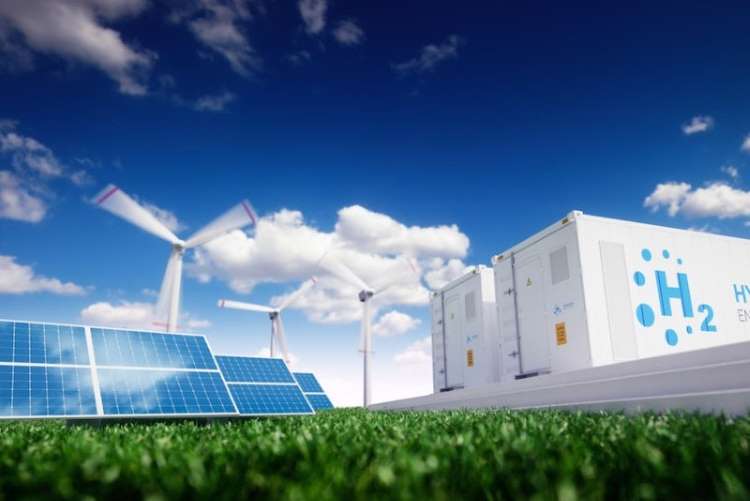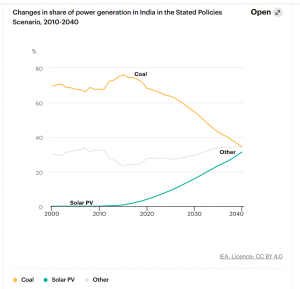
Policy makers and energy researchers are viewing green hydrogen as the fuel of the future as it is a clean and sustainable energy source. Its versatility, long-term storage capability, and decarbonisation potential make it a promising fuel at a time when nations and businesses are struggling to combat climate change and achieve net-zero targets. In this context, it is important to take a close look at the technology and cost issues associated with the clean fuel. The Global Trade Research Initiative (GTRI) has published a policy brief which concludes that green Hydrogen faces significant challenges, making it unsuitable for India at this stage.
Green Hydrogen is produced by splitting water using renewable energy. It is termed ‘green’ because it does not emit greenhouse gases that contribute to global warming. It offers a sustainable and environment-friendly solution to meet the world’s energy needs. It is used in transportation, industry, and power generation and helps reduce the reliance on fossil fuels.
READ I Beyond opulence: Luxury industry embracing sustainable practices
The GTRI paper lists several factors that make green hydrogen unsuitable for India and proposes alternative strategies.
High cost and economic challenges
One of the primary drawbacks of green hydrogen is its high cost compared to standard energy options. On average, it is 6-8 times more expensive than conventional fuels. The cost is influenced by various factors such as the expenses associated with renewable energy sources, electrolysers, transportation, and storage. While the prices may vary depending on the location, the overall economic challenge of adopting the fuel remains a significant concern for India.
Technology and ecosystem development
Green Hydrogen technology and its supporting ecosystem are still in the early stages of development. It will take at least 20 years for the technology to mature and become competitive. Given this timeline, subsidising it in India may not be advisable. There is a need to focus on stabilising the grid power and increasing the share of renewable energy which can be achieved more effectively in the short term.
Challenges in Indian context
India faces specific challenges that make the adoption even more problematic. The country will face high costs, low production efficiency, and inadequate distribution infrastructure for the clean fuel. The production and supply chain are not yet mature enough to make it a viable fuel option. Moreover, the transportation and storage of green hydrogen require specialised infrastructure due to its flammability and corrosiveness, further increasing costs and safety concerns.
Safety concerns and specialised infrastructure
Green Hydrogen poses significant safety concerns due to its highly flammable and corrosive nature. Its transportation and storage require specialised containers, pipelines, and tanks capable of withstanding high pressure, low temperatures, and wear and tear. Addressing these safety concerns adds additional costs to the already expensive ecosystem.
Green hydrogen for steel production
One of the potential applications of green hydrogen is in the production of green steel. However, the cost of producing green steel using it is estimated to be 40-60% higher compared to regular steel production methods. The technology required for large-scale green steel production is still unproven, and significant capital expenditure would be needed to set up the necessary infrastructure and facilities.
Investment in green hydrogen
Global investment trends in green hydrogen reveal low private sector investments and high subsidies from developed countries. Despite the hype surrounding this clean fuel, the private sector has invested less than $30 billion in projects worldwide. This lack of private investment suggests that the high costs associated with the fuel make it economically challenging, even for developed countries.
Substantial subsidies are required to support its adoption, as demonstrated by the European Union’s commitment of $350 billion and the subsidies provided by the United States.
Exploring grey and blue hydrogen
Considering the challenges and costs associated with green hydrogen, India should consider evaluating the use of grey and blue Hydrogen to a greater degree. Grey Hydrogen, which accounts for most of the Hydrogen used worldwide, is primarily produced through an emission-intensive process called steam methane reforming. By capturing a portion of the carbon emissions during production, grey Hydrogen can be transformed into blue Hydrogen.
Blue Hydrogen is produced using the same methods as grey Hydrogen, but has an additional step of carbon capture and storage to reduce emissions. The captured carbon is then stored underground or utilised for other purposes, reducing its impact on the environment. Compared to green Hydrogen, both grey and blue Hydrogen have lower production costs and a more established infrastructure.


While grey and blue Hydrogen are not entirely carbon-free, they can serve as transitional solutions toward a greener energy future. These options can help bridge the gap until the costs associated with green Hydrogen decrease, and the technology matures further. Additionally, by investing in grey and blue Hydrogen, India can leverage its existing natural gas infrastructure and gradually transition toward a cleaner energy system.
Green hydrogen in India’s energy mix
While the potential of green Hydrogen as a clean energy source is undeniable, India currently faces significant challenges that make its adoption impractical at this stage. Factors such as high costs, technology and ecosystem development, safety concerns, and inadequate infrastructure hinder its widespread implementation. However, by exploring alternative options like grey and blue Hydrogen, India can take steps toward a cleaner energy future while leveraging its existing resources.
It is crucial for India to focus on stabilising the grid power and raising the share of renewables in the short term. This needs investment in solar, wind, and other renewable energy technologies that provide immediate and cost-effective transition toward a sustainable energy system. As the technology continues to evolve and costs decrease, India can reassess its feasibility and gradually integrate it into its energy portfolio.
By carefully considering the economic, technological, and environmental factors associated with green Hydrogen, India can make informed decisions and prioritise the strategies that will have the most significant impact on its energy transition. The clean energy transition need to be done in a practical and affordable way to ensure a sustainable and resilient energy future for India.
